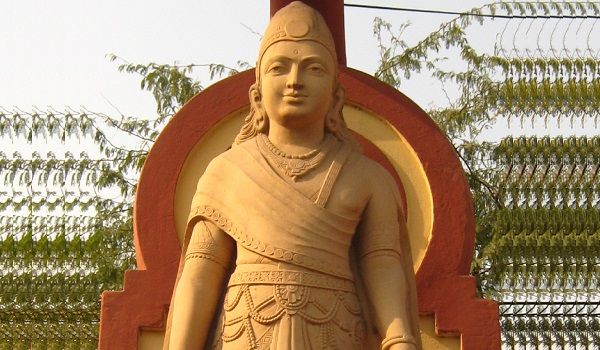
Chandragupta Maurya : Architect of Ancient Indian Empire

Chandragupta Maurya, often referred to by the Greeks as Sandrakottos or Sandrokottos, stands as an iconic figure in Indian history, credited with laying the foundation for the first pan-Indian empire – the Maurya Dynasty. His rule, which commenced in 322 BCE, reshaped the political landscape, establishing a centralized empire and setting the stage for the Mauryan dynasty’s prominence in ancient India.
Early Life and Rise to Power
The early life of Chandragupta Maurya is veiled in myth and legend, with a scarcity of concrete historical evidence. According to some accounts, he was born in 340 BCE in Pataliputra, the capital of Magadha. The primary inscriptional reference to Chandragupta’s history is found in the Junagarh inscription from the 2nd century CE, shedding light on his legacy.
Debates persist regarding his social origins and caste. Various sources present conflicting narratives, identifying him as a member of the Kshatriya Moriya clan, a peacock-tamer, the son of a woman named Mura, or related to the Nandas. While historians differ on his social roots, it is widely accepted that Chandragupta emerged from a modest background, challenging the notion that only those of princely lineage could ascend to the throne.
His ambitious nature became apparent from an early age. Exploiting the political turmoil during the Nanda rule, Chandragupta aligned himself with the strategic brilliance of Chanakya, also known as Kautilya. With Kautilya’s guidance, he defeated the last Nanda ruler, Dhanananda, marking the inception of the Mauryan dynasty.
Military Exploits and Territorial Expansion
Chandragupta Maurya’s military prowess played a pivotal role in consolidating and expanding his empire. Notably, he engaged in conflicts with Seleucus I Nicator, the heir of Alexander the Great, aiming to diminish Greek influence in the east. The war concluded in 301 BCE, resulting in Chandragupta acquiring territories such as Arachosia (Kandahar), Gedrosia (southern Baluchistan), and Paro Amisadai, accompanied by a marriage alliance and the exchange of 500 elephants.
The Mauryan Empire, under Chandragupta’s rule, extended its influence far and wide, reaching the western coast and southern regions of present-day India, including Karnataka. The territorial expanse encompassed not only Bihar and Orissa but also western and north-western India, leaving a lasting impact on the geopolitical landscape.
Administration and Governance
Chandragupta Maurya’s administration was characterized by centralization, with power concentrated in the hands of the king. While there were departmental heads overseeing military, espionage, judiciary, and revenue matters, the king’s decisions held final authority. Viewing his subjects as children to be protected, Chandragupta established a complex administrative structure.
The empire was divided into provinces, each governed by princes who gained valuable administrative experience. Pataliputra, the capital, stood as a testament to the Mauryan administrative prowess. Six commissions, each with five members, handled various administrative tasks, including sanitation, foreign affairs, and registration of births and deaths.
Military Structure and Strength
A defining feature of Chandragupta’s reign was the formidable Mauryan military. Recruiting, training, and equipping troops were crucial aspects of statecraft. The army comprised infantry, cavalry, chariots, and elephants – collectively known as chaturanga. A war office, consisting of six commissions with thirty members, oversaw these military components, including the navy.
Chandragupta commanded a massive army, boasting 600,000 infantry, 30,000 cavalry, and 9,000 elephants. The chariot count reached an estimated 8,000. The deployment of these forces on the battlefield, strategically organized based on terrain and the nature of the conflict, showcased the military acumen of Chandragupta and his commanders.
The Mauryan navy served as a coast guard, safeguarding the extensive waterways-based trade that contributed to the empire’s economic prosperity. Various weapons, from bows and arrows to chariots, reflected the technological sophistication of the Mauryan military. The king and princes, having undergone extensive training, actively led armies and defended forts.
Encounter with Greek Influence and Diplomacy
Chandragupta Maurya’s interactions with Greek powers, particularly the confrontation with Seleucus I Nicator, demonstrated his diplomatic finesse. By securing territories and entering strategic alliances, Chandragupta sought to reduce Greek influence in the Indian subcontinent. The conclusion of the conflict in 301 BCE marked a significant diplomatic triumph, solidifying the Mauryan Empire’s position in the region.
Legacy and Enduring Influence
The circumstances surrounding Chandragupta Maurya’s death remain a subject of debate. Historical evidence, coupled with common belief, suggests his adoption of Jainism in later years. Inscriptions in Karnataka from the 5th to 15th centuries CE associate Chandragupta with the Jain saint Bhadrabahu. It is widely accepted that he embraced asceticism, followed Bhadrabahu to Karnataka, and ultimately practiced sallekhana, fasting until death.
Chandragupta Maurya’s rule spanned 24 years, leaving an indelible mark on ancient Indian history. He was succeeded by his son Bindusara and later by the renowned Ashoka the Great. Chandragupta’s legacy is not merely confined to territorial conquests but extends to governance principles, military strategies



